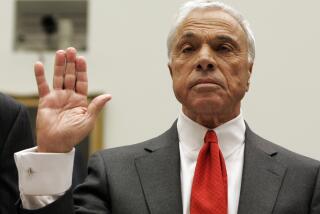Mortgage-Backed Securities Are Recovering
- Share via
Real estate investors are breathing easier as the commercial mortgage-backed securities market rallies after a late-summer crash that sharply raised the cost of borrowing.
“The market is healing,” said mortgage banker George Smith of Century City. “We’ve had a handful of casualties, but 90% [of the CMBS originators] are back.”
The state of the CMBS market has implications for a broad spectrum of commercial property buyers and investors because CMBS lending, which only a few years ago accounted for a mere fraction of commercial real estate financing, now accounts for as much as half of the lending on loans for commercial properties in the United States. CMBS lenders sell bonds backed by large pools of mortgages, with the mortgage payments from borrowers providing the cash flow to, in turn, pay the interest due to bondholders.
Smith and other observers say the recent sale of $2 billion in CMBS by Lehman Bros. and a $1.87-billion issue by Donaldson Lufkin Jenrette--and the prospect of other bonds due to be issued soon--are signs that the market is on the road to recovery after some of its key players lost billions of dollars when the bottom fell out in late August and early September.
Among the casualties of the CMBS crash was Nomura Holding America Inc., the top U.S. commercial mortgage lender, which said last week that it is quitting the real estate finance business. Nomura said it is shutting down the lending business of its real estate finance arm, Capital Co. of America, after losing $1.16 billion in the half-year period through September.
What has been referred to as a “meltdown” in the CMBS market occurred when the spreads widened quickly and dramatically between the yields on CMBS bonds and the yields on 10-year Treasury bonds, the benchmark with which CMBS bonds are compared. In general, profits shrink for CMBS lenders when spreads widen between CMBS yields and Treasury yields. Since most CMBS issuers were operating on thin margins anyway, the dramatic widening of spreads last summer cost the CMBS lenders billions in lost profits.
Now, however, Smith said, spreads are narrowing and CMBS lenders are building wider profit margins into their deals.
“The CMBS lenders are not going to work on the razor-thin margins they did before because they now realize they took too much risk for the profit,” Smith said. He added that the CMBS market has been helped by the recent decline in yields on Treasury bonds, making CMBS more attractive to investors.
The recovery of the CMBS market is good news for anyone who borrows money on commercial real estate because it translates into lower rates for borrowers, according to Larry Bond, managing director of Century City-based Summit Fund. He explained that when CMBS lenders’ profits began disappearing as a result of widening spreads, the CMBS lenders had to start charging higher interest rates to commercial mortgage borrowers in an effort to return to profitability.
“The CMBS market affects our borrowing costs, so we’re always happy when the market rallies,” said Bond, whose company invests in commercial properties in joint ventures with other partners.
Bond said Summit is paying between 7.25% and 7.50% interest on its loans now, compared with rates of 7.75% and up when the CMBS market stumbled.
“That might not seem like much of a difference, but half a percentage point of savings can be very significant in the commercial real estate world. On a $10-million loan, a half a [percentage point] over 10 years can mean a difference of $500,000,” Bond said.
Despite its improvement, the CMBS market still has a long way to go to fully recover, according to David Rogers, managing director of Finova Realty Capital in Irvine, the commercial mortgage banking subsidiary of publicly held Finova Group Inc.
Rogers pointed out that lower-rated CMBS bonds remain difficult to sell despite the recovery in the “investment grade,” or AAA-rated, bonds.
“We have not returned to the sub-100 spreads that existed at the end of the summer, but the return toward normal has been unexpectedly swift and strong” in the AAA-rated bonds, Rogers said. However, he said, lower-rated bonds “are still trading at wide spreads,” and there are still CMBS lenders losing money on the lower-quality bonds.
Rogers said the CMBS market has grown into one of the primary sources of financing for commercial properties in the last several years, especially for deals in the $3-million to $20-million range. While some of the largest players in the commercial real estate industry finance their purchases and investments with direct bank loans and lines of credit, he said, much of the middle market depends on funding from CMBS lenders.
According to Rogers, the CMBS market collapsed not because of any problems inherent in the real estate industry but because of problems in the credit markets related to the U.S. stock market plunge and economic woes in Asia and Russia.
Before the CMBS meltdown, he said, the spread between Treasuries and CMBS issues had held steady at about 100 basis points, or 1%, for quite some time. But the spreads doubled to more than 200 points within two weeks, wiping out the CMBS lenders’ profits and resulting in reverberations such as the Nomura decision to quit the business.
According to Smith, the meltdown has led to a CMBS industry that will operate more conservatively and return to broader profitability next year.
“There are some casualties, but the concept of the CMBS business itself, as a predictable source of lending for properties with predictable cash flow, has been validated,” he said. “It’s very likely to be a $50-billion- to $60-billion-per-year business again.”
More to Read
Inside the business of entertainment
The Wide Shot brings you news, analysis and insights on everything from streaming wars to production — and what it all means for the future.
You may occasionally receive promotional content from the Los Angeles Times.










